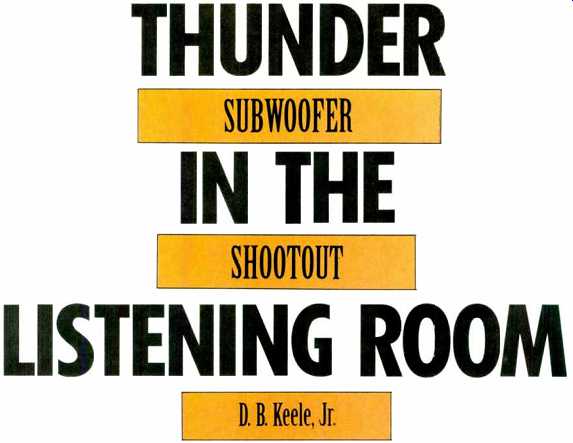
by D. B. Keele Jr.
Hooked on bass and can't get enough of it? Turning up your bass control doesn't add low bass so much as boost the upper bass, which you already have enough of--and when some really powerful low bass notes come along, all that comes out of your speakers is distorted mush. And if you have high-end equipment, where tone controls are considered to detract from he purist, straight-wire sound, there isn't even a bass control to turn.

above: Clockwise from upper left: Infinity SSW-210 with grille
removed, Hsu Research HRSW 10, Alter Lansing PS1V10, and Velodyne F-I500
with grille detached.
If lack of bass is your problem, sub woofers are the solution. Because they're optimized to reproduce bass, subwoofers won't wilt when handling high-level deep-bass signals. This gives you extra freedom in getting the exact bass level you want. And because they handle only bass, it's hard o tell where their sound is coming from, which gives you the freedom to place them where they'll sound best and look (east obtrusive. What's more, handing the bottom octave or two over o subwoofers frees your full-range systems and the amplifiers driving hem from the demanding requirements of high-level bass. Combining subwoofers with small systems that lack low bass response but offer superior imaging and more even coverage can often give you greater sound for the buck than larger, more expensive full-range systems.
Thanks to the popularity of home theater systems, subwoofers are more plentiful than ever: Audio's 1992 Annual Equipment Directory lists almost 300 of them. To help you choose, this review compares four subwoofer systems covering a fairly wide range of prices (from $750 to $1,495 per system) and design approaches. Two systems, the Altec Lansing PSW10 and Infinity SSW-210, are from well-known speaker manufacturers. The Velodyne F-1500 comes from a well-known sub woofer specialist, and the Hsu Research HRSW 10 comes from a new company that also produces only sub woofers. All but the Hsu Research are powered, closed-box designs, sold individually. The HRSW 10, however, is a passive, vented woofer sold in pairs.
All three self-powered speakers include active low-pass filters (plus an active high-pass, in the Velodyne) as well as circuitry to protect the drivers by limiting excursion when the signal includes high-level low-frequency information. They also have left and right line-level and speaker-level inputs, so they can reproduce the bass from both stereo channels.
The Altec Lansing PSW10 includes a single 10-inch long-throw woofer mounted on the bottom of its raised, walnut cabinet, plus a 100-watt amplifier and an active crossover mounted in the box. A panel holds "Equalizer" and "Volume" controls, a knob to select crossover frequencies (of 50, 80, 100, or 150 Hz), and pushbuttons to select crossover slope (18 or 24 dB/octave) and normal or inverted polarity. There's no on/off switch, because the system turns itself on when it receives a signal, but there is a "Power" LED. Another LED, just below, shows the status of the Dynamic Equalization excursion limiting circuitry.
The Hsu Research HRSW 10 consists of two cylindrical cabinets (to minimize side-wall flexing), each containing a 10-inch long-throw woofer, plus an external passive crossover network.
The enclosures are vented by long internal port tubes that run nearly the full height of the cabinets and exhaust at the bottom, next to the drivers. The cabinets are wrapped in black knit cloth, with a wood cap at the top. Poh Ser Hsu, the designer, calls his systems "true subwoofers" because they can produce high output down to 20 Hz with low distortion, to differentiate them from subwoofers that go down to just 30 or 40 Hz, as many of them do.
==============
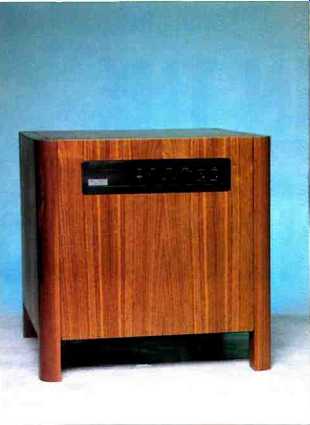
ALTEC LANSING PSW10
Manufacturer's Specifications:
Enclosure Type: Sealed box.
Driver: 10-in. cone.
Power: Built-in Class-B amplifier, 100 watts out at 0.1% THD.
Frequency Response: 26 to 180 Hz, ±3 dB.
Crossover Frequencies: 50, 80, 100, or 150 Hz, selectable.
Crossover Filter Slopes: Low-pass, 18 or 24 dB/ octave, selectable.
Dimensions: 17 3/8 in. H x 17 3/8 in. W x 17 3/8 in. D (44.1 cm x 44.1 cm x 44.1 cm).
Weight: 57 lbs (25.9 kg).
Price: $850 each.
Company Address: P.O. Box 277, Milford, Pa. 18337.
==============
Even so, at $750 per pair, the Hsu system is the least expensive of the subwoofers reviewed here, though no amp is supplied. The passive crossover is a separate box, with speaker level inputs that are driven from the same amp as the satellite speakers but with line-level outputs to feed a separate stereo amplifier that drives the two subwoofers. Hsu recommends 40 to 300 watts per channel and says that, with room gain, a 40-watt amplifier will be enough to deliver levels of 109 dB SPL at 1 meter, even at 20 Hz.
Infinity's SSW-210 houses two 10 inch long-throw drivers, a 250-watt amplifier, and a crossover. Its slant-sided cabinet, essentially a rectangular block with one corner cut off, allows it to be placed in (and loaded by) a room corner or placed on the floor behind a piece of furniture. It can also be used upright, and optional end panels turn it into a low table that angles the drivers downward for floor loading. On its rear panel are a level control, a continuously variable control for the frequency of the low-pass crossover filter, and an on/off switch. In addition to the built-in low-pass filter, Infinity offers both line level active and speaker-level passive high-pass filters as options. Some Infinity literature mentions servo control, but there is no direct motional feedback in the system, although the amplifier does use positive current feedback techniques to reduce driver distortion.
The Velodyne F-1500 does use high gain motional feedback servo techniques to control its 15-inch driver. Like all Velodyne subwoofers, it uses a piezoelectric accelerometer attached to the driver's voice-coil to sense drive movement, then uses feedback from the accelerometer to linearize the driver's motion and reduce its distortion.
The built-in 250-watt servo amplifier also contains a protective limiter (see Audio's November 1987 review of the Velodyne ULD-15 for an in-depth discussion of the servo system). The F1500 is the only system reviewed here that has a full crossover, including a high-pass filter to limit low-frequency feed to the satellites; both line- and speaker-level high-pass outputs are provided. Controls on the rear allow for level adjustment, continuously varying the crossover frequency, and power switching. At $1,500, the F-1500 is the highest priced of the four systems I evaluated.
Measurements
Figure 1 shows the frequency responses of the four systems, with each curve's maximum plotted at 0 dB. Near-field and ground-plane techniques were used in the gathering of response data. Curves were run at sufficiently low levels that protective limiters or compressors, where present, did not operate.
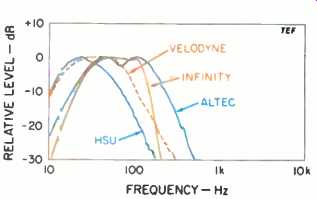
Fig. 1--Frequency response of all four subwoofers.
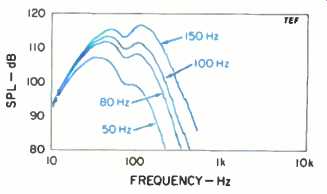
Fig. 2--Effect of crossover-frequency settings on the response of the
Altec Lansing PSW 10, at 24-d8/octave crossover slope.
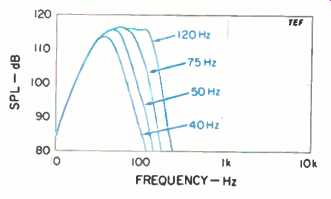
Fig. 3--Effect of selected crossover-frequency settings on the response
of the Infinity SSW-210.
Each system's crossover controls were set to their highest frequency and fastest roll-off, and any other controls were adjusted for flattest response. For the Altec PSW10, the settings were "Volume" fully clockwise, "Equalizer" at the 1:00 position, normal polarity, and a crossover of 150 Hz and 24 dB/ octave. The Hsu HRSW 10 was driven directly from my amp, and the resulting curves were adjusted to reflect the measured response of the low-pass crossover filter. For the Infinity SSW 210, level and frequency controls were set fully clockwise. The Velodyne F 1500's volume control was set to its mid position ("5"), and the crossover low-pass was set at 100 Hz. Input levels for this test were 10 mV rms into the line-level inputs of the three active models and 2.83 V rms (1 watt, at its rated impedance of 8 ohms) for the Hsu Research unit.
The response measurements can be grouped into two different categories: Low-frequency extension to 30 Hz (Altec and Infinity) and to 20 Hz and below (Hsu and Velodyne). These response curves are not the whole story.
In an active, or powered, system, the designer can theoretically apply response equalization to make the system flat down to any frequency he chooses-but with the danger that pushing a driver beyond its capabilities can lead to distortion or even damage. What matters is how loud the system will play at each frequency at a reasonable distortion level, not how flat it measures at low signal levels. Getting audible 5-Hz output from a 5-inch driver is an exercise in futility, no matter how big your power amp, even if you could design a 5-inch woofer with an 18-inch excursion. Distortion data at specific levels and frequencies, and maximum acoustic output information-both of which have nothing to do with the flatness or lack thereof of low-level frequency response-are required for assessing the effective performance of a subwoofer. Distortion and maximum output data will be shown later.
The upper frequency limits of the systems cover a broad range, from a low of 40 Hz for the Hsu subwoofer (which can be purchased with higher crossover frequencies) and up to 160 Hz for the Altec. The half-power (-3 dB) frequencies for the subwoofers were: Altec, 31 to 160 Hz; Hsu, 14.3 to 40 Hz; Infinity, 28 to 123 Hz, and Velodyne, 17.5 to 70 Hz. These figures were all reasonably close to the manufacturers' ratings. Measured upper frequency acoustic roll-off rates (which include the driver's own roll-off in addition to the crossover's) were sometimes steeper than specified. Measuring at levels of -10 to 30 dB (where the roll-off is most important for proper matching to satellite speakers), I found the slope to be 12 dB/octave, as rated, for the Velodyne, 18 dB/octave for the Altec (when set for 24 dB/octave) and the Hsu, and a very rapid 42 dB/octave for the Infinity. The only significant frequency anomaly was a dip of about 2.5 dB in the Altec's response in the 1/3 octave centered at 65 Hz. Altec's designer revealed that this was because the dip filter intended to tame the system's primary woofer-box resonance was somewhat misaligned in my test sample.
I chose not to present any phase response curves because of the large variety of available responses. Also, because each system was essentially minimum-phase, its phase performance would be directly rated to its frequency response, thus presenting no surprises.
Figure 2 shows the crossover responses of the Altec PSW10 in its 24dB/octave roll-off mode. The EQ control was set to the 0-dB, straight-up, position, with the volume control at maximum. The curves were run with 10 mV applied, and the resultant near field sound pressure was noted. The test microphone was placed 1/4 inch away from the center of the woofer's dome. The curve family exhibits significant changes in level as the crossover frequency is varied. When the response maximums were normalized to 0 dB (not shown), the upper frequency limits (-3 dB points) were 51, 58, 117, and 151 Hz as compared to the rated values of 50, 80, 100, and 150 Hz. The family of curves at the 18-dB/octave setting (not shown) was similar to those for the 24-dB/octave family except for greater level above 50 Hz and a measured acoustic roll-off rate closer to 12 dB/octave.
The Altec's EQ control mainly affects the frequency response in the two-octave range from about 15 to 60 Hz, with maximum influence at 30 Hz. The EQ circuit basically just boosts, but because of driver roll-off, overall response is flattest with the control near the zero point of its "-9" to "+9" dB scale. At 30 Hz, the total boost measured about 22 dB with the control fully clockwise (-13 to +9 dB referenced to the control's 0-dB position). The Dynamic Equalization circuits of the PSW10 partially eliminate this boost at high levels. With the usual settings of the EQ control (mid to full rotation), this action serves to provide a subjective high level of bass at low to moderate levels but decreases the amount of boost at high levels so that the system will not be overdriven. My tests revealed that the boost was reduced very suddenly when the threshold level was reached. At threshold, an increase of only about 0.5 dB would turn the boost off completely.
============
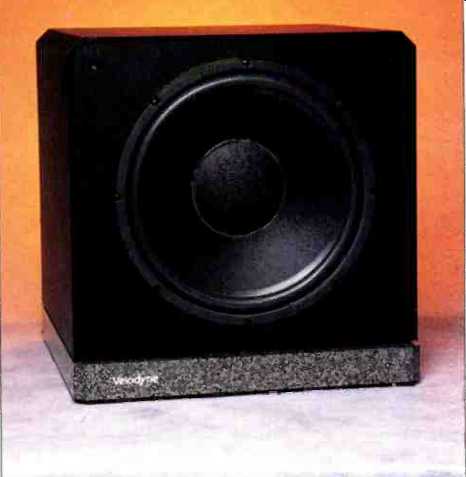
VELODYNE F-1500
Manufacturer's Specifications:
Enclosure Type: Sealed box.
Driver: 15-in. cone with servo accelerometer attached to voice-coil.
Power: Built-in Class-AB amp, 250 watts continuous.
Frequency Response: 18 to 85 Hz, ±3 dB.
Crossover Frequencies: Low-pass filter, 40 to 100 Hz, variable; high-pass filter, 85 Hz.
Crossover Fitter Slopes: Active low-pass, 12 dB/ octave; passive high-pass, 16 dB/octave.
Dimensions: 20 in. H x 20 in. W x 20 in. D (50.8 cm x 50.8 cm x 50.8 cm).
Weight: 79 lbs. (35.9 kg).
Price: $1,495 each.
Company Address: 1070 Commercial St., Suite 1012, San Jose, Cal. 95112.
===========
Figure 3 discloses the crossover responses of the Infinity SSW-210 with the crossover-frequency control at the positions indicated and the level control at maximum clockwise. Test conditions were the same as for the Altec system, with the microphone in the near field of one of the two woofers.
The responses of the two woofers were very closely matched. The roll-off rate was significantly more rapid at the highest crossover-frequency setting than at the lowest (42 dB/octave at 120 Hz versus 24 dB/octave at 40 Hz). If the response maximums were normalized to 0 dB, the upper frequency limits (the points where response was 3 dB down) would be 46, 57, 76, and 125 Hz.
The responses of the Velodyne F1500 for three settings of its variable crossover-frequency control are shown in Fig. 4. As I did when testing the Altec and Infinity, I set the mike 1/2 inch from the center of the driver's dome and applied a signal of 10 mV rms to the system's line-level input. Because the Velodyne's gain was substantially higher than that of the Altec and Infinity systems, however, I set its volume control at its mid position. With the volume at maximum, only 1 mV was required for substantial bass levels. As with the Altec system, varying the crossover frequency also significantly changed the gain. Normalizing the response peaks as before showed that the upper low-pass filter's cutoff frequency could be adjusted only for -3 dB points from 52 to 71 Hz, significantly narrower than the 40 to 100 Hz indicated on the control dial. If the Velodyne were to be used with mini-monitor satellite systems having limited low-frequency capability, this relatively low upper crossover point would present blend problems in achieving flat response in the upper bass.
The compressor-limiter circuits of the Velodyne were very effective. With a sine-wave input increasing in level, the system would simply stop getting any louder when the excursion limits of the woofer were reached. This limiting was done very smoothly and without any extraneous audible effects. For very high inputs, the Velodyne protected itself by shutting down its power amplifier until the overload went away.
With the volume control at mid position, the system shut down after a couple of seconds when a 20-Hz-signal at a level of 400 mV was applied to the line-level input. Raising the input from 50 to 400 mV, an 18-dB increase in level, resulted in only a 2.4-dB increase in output level.
The Hsu HRSW 10 subwoofer is the only one of the four systems evaluated here that is not self-powered, so somewhat different tests were run. An additional complication I faced was that the Hsu subwoofer is supplied as two separate units containing individual 10 inch woofers with an external low-pass passive crossover filter. Should I compare just one of the Hsu systems or the pair with the other systems? I chose to compare a pair of Hsu systems connected in parallel.
Figure 5 shows the 1-meter axial response of the pair of Hsu systems, connected in parallel, with 2.83 V rms applied (2 watts into 4 ohms, driven without the external low-pass filter). The subwoofers were actually measured on the ground plane at a distance of 2 meters. The HRSW 10s were upright, side by side, and raised 21/2 inches above the floor (the height provided by the supplied spikes). A single system measured under the same conditions exhibited a curve 6 dB lower in level (84 dB at 100 Hz instead of 90 dB). Below 100 Hz, the axial response rolls off smoothly and is down about 11.5 dB at 20 Hz. When the system was driven with an amplifier being fed by the supplied passive low-pass filter (whose response is not shown), the system's response appears as in Fig. 1. A high-O dip in the axial response is evident at about 260 Hz. This is a result of the primary organ-pipe resonance of the long vent tubes that tune the systems to 20 Hz.
Figure 6 shows the impedance magnitude of a single Hsu system. If two systems are operated in parallel, the impedance will be one-half the values seen in the graph. The minimum impedance of a single HRSW 10 just barely drops below 8 ohms at the system's 20-Hz tuning frequency. Rather high maximums of 41 and 115 ohms are reached at the lower and upper vented-box impedance peaks. The high peak impedance values actually indicate a good driver design that derives most of its damping from electromagnetic effects due to current flow through the voice-coil rather than from mechanical losses. This impedance should be an easy load for any amplifier to handle.
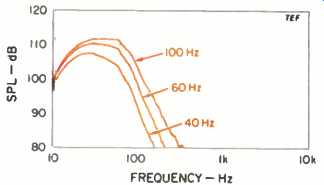
Fig. 4--Effect of selected crossover-frequency settings on the response
of the Velodyne F-1500.
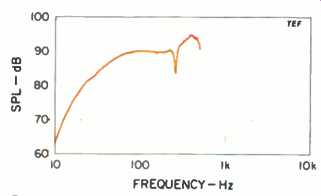
Fig. 5--One-meter, on-axis anechoic frequency response of the pair of
Hsu Research HRSW 10 subwoofers, with input of 2.83 V rms.
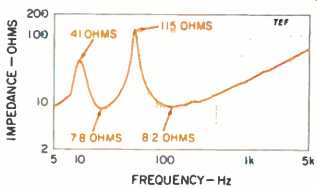
Fig. 6--Impedance of a single Hsu HRSW 10.
Figures 7 to 10 show the results of harmonic distortion tests. A suite of sine-wave distortion tests were run at nine third-octave center frequencies from 16 to 100 Hz at axial levels ranging from 70 to 110 dB SPL. The actual measurements were all near field but referenced to 1-meter free-field levels. No room gain was taken into account.
The harmonic distortion readings shown were made by summing the power in the first 20 harmonics of the fundamental, referencing this power to the fundamental's power, and then calculating the percentage of distortion.
Effectively the method yielded results very close to total harmonic distortion (THD), which includes the power in all the harmonics. In all the tests, the second and third harmonics of the fundamental predominated.
Each frequency was first raised to an equivalent 70-dB SPL fundamental level, and distortion was measured. The level was then increased in 2-dB steps until the distortion became excessive (usually in the range of 40% to 60%), the output stopped increasing, or the power capability of the driver was exceeded--whichever occurred first.
(Note that the curves for the lowest frequencies are at the rear of the charts, placed there so that their higher distortion would not obscure the readings at the higher frequencies.) In Fig. 7, the results for the Altec, the distortion is reasonable down to 50 Hz and at levels up to about 100 dB SPL. At lower frequencies, the distortion rises much more rapidly until level-limiting sets in at the lowest frequencies.
Below 32 Hz, the distortion rises very rapidly with level.
==========
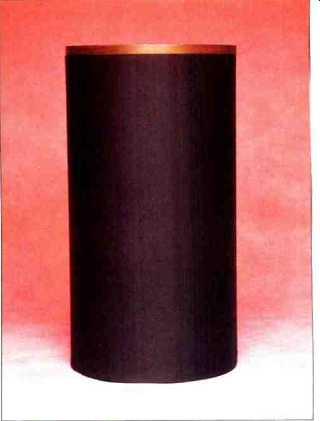
HSU RESEARCH HRSW 10
Manufacturer's Specifications:
Enclosure Type: Dual, vented boxes.
Driver: 10-in. cone in each enclosure.
Recommended Power: 40 to 300 watts per channel.
Frequency Response: 16 to 40 Hz, ±3 dB.
Rated Impedance: 8 ohms.
Crossover Frequencies: 40 Hz; 40 to 100 Hz available on special order.
Crossover Filter Slopes: Low-pass, 12 dB/octave; 18 dB/octave available on special order.
Dimensions: 29 in. H x 14 1/2 in. diameter (73.7 cm x 36.8 cm).
Weight: 23 lbs. (10.4 kg) each.
Price: $750 per pair with walnut top and standard passive crossover; other finishes, $50 additional for light oak top, $100 additional for rosewood; crossover options, $50 extra for passive crossover with 18-dB/octave slope, $30 extra for special frequency, $350 for active crossover.
Company Address: 20013 Rainbow Way, Cerritos, Cal. 90701; 800/554-0150.
==========
The distortion of the Hsu subwoofer is shown in Fig. 8. The distortion reaches maximums of only about 15% for 100 dB at 25 and 32 Hz. At 16 and 20 Hz, the maximum sound levels are limited by the power capability of the woofer. The distortion-reduction capability of the Hsu's vented-box design is clearly evident in the 16and 20-Hz bands. Between 80 and 90 dB SPL the distortion is actually somewhat less at 16 and 20 Hz than at 25 and 32 Hz.
The distortion reaches only about 6% for 90 dB at 16 and 25 Hz. At 40 Hz and above, loud levels of about 104 to 106 dB can be reached with quite reasonable levels of distortion.
Figure 9 shows the distortion data for the Infinity SSW-210. The performance of this system ranks between that of the last two systems. At 50 Hz and above, the distortion is very reasonable. Below 50 Hz, however, distortion increases rapidly as frequency is lowered. At 25 Hz, a usable 88 dB SPL is reached at about 15% distortion.
The distortion data for the Velodyne system is shown in Fig. 10. Incredibly, the distortion reaches a maximum of only 2% in the 20-Hz band! The very beneficial effect of the servo is quite evident in holding the distortion down at all frequencies and levels. The maximum levels were set by the action of the system's limiter circuits. The Velodyne was always extremely well behaved during most of these tests and generated only the given low-frequency tone, without any audible distortion or noise. It is the cleanest low-frequency reproducer I've ever heard. The only extraneous sounds generated occurred when a very high-level sine wave signal was suddenly applied to the F-1500: At that point, an overload related clicking sound was generated briefly before the system's limiters came into operation.
Figure 11 shows the subwoofers' short-term, 1-meter, free-field peak acoustic output capabilities as a function of frequency. The test signal used was a 6.5-cycle shaped tone burst with a third-octave bandwidth. The "room gain" of a typical listening room at low frequencies, which adds about 3 dB to the response at 80 Hz and 9 dB at 20 Hz, has been added to all these curves. Tests were run over the range from 16 to 200 Hz. The outputs of the systems were monitored both by ear and with an oscilloscope to check the produced waveforms. The input to the systems was increased until reasonable visible or audible distortion developed, whichever occurred first, and then the peak output sound pressure was noted. Since the Velodyne produced no distortion I could hear or see on the 'scope, its output limit was set by its protection circuits. This placed it in a class by itself. For example, even though the graph shows the maximum output of the Hsu (tested here with both systems operating in parallel) exceeding the Velodyne by a few dB, its output was almost invariably more distorted than the Velodyne's, even when producing the same sound level.
The Altec's output starts at 80 dB SPL at 16 Hz, rises rapidly with frequency, and then levels off at about 110 dB above 50 Hz. Its output was the lowest of all the systems.
The Infinity starts out much higher, 96 dB at 16 Hz, rises with frequency to reach a peak of 119 dB at 100 Hz, and then falls rapidly. Its drop above 125 Hz seemed to be due to some internal electronic limiting action and not power amplifier or woofer limiting. Between 80 and 160 Hz, the Infinity's output was second highest, and exceeded the Velodyne's. At 16 Hz the Infinity's maximum output was within 3 dB of the Velodyne and Hsu systems' The Hsu exhibited the highest maximum acoustic output of all the systems (with both cabinets operating in close proximity). As mentioned before, although its output exceeded the second-place Velodyne's in the important range from 16 to 50 Hz, its output was significantly more distorted than the Velodyne's. The Hsu essentially exceeded 110 dB SPL at 20 Hz and above, and 120 dB above 80 Hz. Note that these outputs were attained with an effectively unlimited amount of power from a very powerful amplifier.
The maximum peak electrical input power of the Hsu (not shown) started at 210 watts at 16 Hz, rose to 700 watts at 20 Hz, fell to 450 watts at 25 and 32 Hz, and then rose to a plateau of about 2,200 watts above 80 Hz.
The Velodyne's maximum peak output was the cleanest, though not the highest, of all the tested systems. At the highest levels, the Velodyne's limiters changed the envelope of the tone burst test signal from its original shape, peaked in the center, to something closer to a constant-level burst. Although the burst's envelope changed, at no time did the individual cycles of that burst become more distorted.
Effectively, the Velodyne and Hsu subwoofers are fairly close in maximum output, but the Velodyne has a definite edge in generating clean output. The Infinity system was a reasonably close third in level to the Velodyne and Hsu, with the Altec following behind. At 32 Hz and below, the Altec was not in the same league as the other systems, however.

Fig. 7--THD vs. SPL and frequency for the Altec PSW 10.
Fig. 8--THD vs. SPL and frequency for the Hsu HRSW 10.
Fig. 9--THD vs. SPL and frequency for the Infinity SSW-210.
Fig. 10--THD vs. SPL and frequency for the Velodyne F-1500.
Use and Listening Tests
I did a moderate amount of informal listening to the subwoofers individually by simply adding each of them to whatever main speakers I happened to have set up at the time. The main speakers were not high-passed, and experimented with various woofer locations. The self-powered subwoofers were more amenable to this experimentation because they didn't require any other added equipment. My initial impressions placed the Velodyne and Hsu units on top, closely followed by the Infinity, with a decent showing by the Altec.
Hooking up the three powered systems (Altec, Infinity, and Velodyne) was simply a matter of connecting their speaker-level inputs in parallel with my main speakers and adjusting the speakers' controls for best blend and balance. Hooking up the Hsu systems was more complicated, involving the passive low-pass filter supplied plus an extra amplifier.
With all this added bass capability in my listening room, I had to get out all my CDs that have deep-bass sound effects, including tracks with thunder, cannons, fighter planes, helicopters, trains, etc. Having lots of good clean bass is exhilarating! Serious listening and direct comparison was done with a much more complicated setup, designed around a distribution power amplifier and speaker switcher, that allowed instant comparisons between the four subwoofer systems. My main speakers were a pair of PSB Stratus Minis, small, high-performance two-way systems with 5-inch vented woofers. Other equipment consisted of a Bryston .4B preamp and 4B power amplifier driven by Onkyo and Rotel CD players. The main speakers were high-passed at 80 Hz with a line level resistor-capacitor (RC) 6-dB/octave filter in my system's tape loop. An extra power amplifier (a Crown Macro Reference) was added between the output of the main amplifiers and the inputs of all the subwoofers to act as a speaker-level bass distribution amplifier. (This was admittedly overkill, because the added amp was essentially used only to drive the comparatively high-impedance speaker inputs of the individual powered subwoofers and of the Hsu filter.) To compensate for the bass roll-off from the RC network I'd installed in my tape loop, I added a second complementary network to the input of the distribution amp, ensuring that a flat signal would reach the sub woofers. This amplifier's level control then allowed the levels of all the sub woofers to be raised and lowered together (although only one subwoofer was selected at a time with the speaker switcher). A relatively low-power (50 watts per channel) Crown D-75 was used to drive the pair of Hsu subwoofers (one per channel), which were placed next to each other for maximum coupling, and was driven by the supplied Hsu low-pass filter. I used this rather small amplifier because Hsu Research states that even the amplifier from an inexpensive receiver can be used to drive their systems. The clipping indicator on the D-75 was invaluable in setting maximum levels. Although this amount of power was quite adequate, more would be beneficial. Hsu suggests that their systems can also be used as stands for small main loudspeakers.
===========
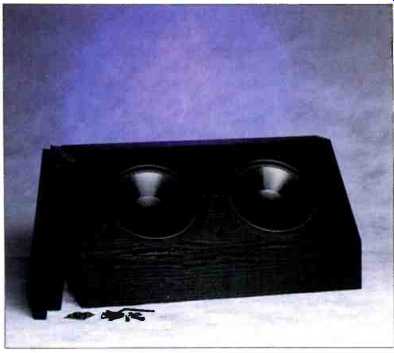
INFINITY SSW-210
Manufacturer's Specifications:
Enclosure Type: Sealed box.
Drivers: Two 10-in. cones.
Power: Built-in amplifier, 250 watts continuous.
Frequency Response: 25 to 120 Hz.
Crossover Frequencies: Variable, 40 to 120 Hz.
Crossover Filter Slopes: Low-pass, 36 dB/octave.
Dimensions: 18 3/8 in. H x 26 in. W x 94 in. D (46.7 cm x 66 cm x 24.8 cm).
Weight: 58 lbs. (26.3 kg).
Price: $1,098 each; optional end panels, $58 per pair.
Company Address: 9409 Owensmouth Ave., Chatsworth, Cal. 91311.
===========
All four systems (five, if you count the Hsu pair separately) were then placed in close proximity to each other, behind the right main system, and positioned halfway between the main system and rear wall. Previous experimentation had determined that this woofer location provided a good balance between smooth response and positive boundary enhancement at my listening location. Between listening sessions, the locations of the sub woofers in the grouping were scrambled a couple of times, decreasing any tendency to identify a particular sub woofer with a sound that was actually a function of its position in the room.
With the use of an AudioControl SA 3050A third-octave real-time analyzer and pink-noise generator, the individual level and crossover controls of each system were adjusted to match the acoustic outputs of the subwoofers to each other, and to best blend with the main systems. This matching was done at a low enough level so that the Altec was operating below its dynamic EQ threshold. After balancing, the controls of the powered systems were set as follows: The Altec's EQ control was set at full, crossover frequency at 80 Hz, crossover slope at 24 dB/octave, and polarity normal. The Infinity's crossover frequency was set at 75 Hz, and the Velodyne's at 70 Hz. The Hsu's lower crossover point left something of a hole in the overall response between these subwoofers and the main speaker systems.
The first CD I listened to was one supplied to me by Hsu that had specific passages containing deep bass.
Saint-Satins' Symphony No. 3, the "Organ Symphony" (Philips 412 619-2), contains an almost pure 17-Hz pedal note at 9:04 into the second movement. Both the Velodyne and Hsu systems generated truly awesome room shaking bass with an effect that I can best describe as the air pulsating around me. The Infinity's output, although quite clean, was much reduced at the fundamental, while the Altec's output was audibly distorted.
On less demanding material with minimal low bass (32 Hz and below), all four systems did a good job. The Altec performed well as long as it was operated below its dynamic EQ threshold; above this level its low-bass output was greatly reduced, although what was left was clean. When the Altec was operated near its threshold, often the bass could be heard to fluctuate or modulate in level as the bass program material went above and below the threshold. This didn't necessarily sound bad, but it was quite obvious when this subwoofer was compared with the other systems.
The Hsu competed very well with the Velodyne at all frequencies and levels, but I continually had to monitor its amplifier to ensure operation below clipping when reproducing deep bass material. Even when clipping, the effect was not very audible, particularly if it occurred when there was program material at higher frequencies to mask the resulting distortion products. The 50 watt amplifier feeding the Hsu clipped when that subwoofer was delivering about the same acoustic output level as the Velodyne was at its onset of limiting. With a more powerful amp driving the Hsu, clipping would have occurred at higher levels. However, the Velodyne's input could be turned up well past the limiting point without causing any audible distortion, though without causing any increase in output, either. This seamless operation of the Velodyne's limiting action turned out to be one of the speaker's greatest advantages. It makes operation effortless, because you needn't be afraid of inadvertently overdriving the system and generating excessive distortion. The three remaining systems would distort, sometimes badly, if overdriven.
Note, however, that the three self powered systems (even the Infinity and Altec, which distorted at high levels) could not be damaged by high input levels. Though the Hsu could theoretically be damaged, Fig. 11 shows that it would take very high power levels to do so.
When listening to the subwoofers by themselves (mains off), at moderate levels with pink noise, I could hear appreciable bleed-through of higher frequencies on all the systems except for the Infinity. This made the Infinity's sound somewhat cleaner on this admittedly specialized test, presumably due to the more rapid roll-off of the Infinity's low-pass crossover.
The Hsu and Velodyne reproduced band-limited third-octave noise very impressively, especially in the 20- and 25-Hz bands, where these two speakers had all the windows and doors in the room vibrating and shaking! At the same levels, the Infinity was distorted at 20 and 25 Hz but was okay at higher frequencies. The Altec was badly distorted at the 20-, 25-, and 32-Hz bands but kept up with the other systems at 40 Hz and above.
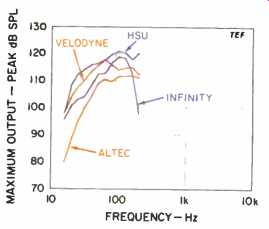
Fig. 11--Maximum peak sound output vs. frequency, including the effects
of room gain.
On high-level rock 'n' roll bass, such as the ZZ Top "Gimme All Your Lovin" from Eliminator (Warner Bros. 23774-2), the Velodyne, Hsu, and Infinity systems could all be turned up to gut-thumping concert levels. I had no clear preference for one over the other. The Altec could not reproduce the same levels due to the limiting imposed by the threshold of its dynamic equalization.
The kick drum on track 5 of the Sheffield Track/Drum Record CD (Sheffield CD-14/20) was rendered extremely well by all three of the larger systems, but I had a slight preference for the sound and tightness of the Infinity. The Altec did an adequate but not exceptional job. On average program material containing high-level upper bass but no loud deep bass, the Altec performed as credibly as the other systems did.
In summary, if you want it all, the Velodyne is the subwoofer of choice. !f you are on a low budget and don't mind the added complexity, the Hsu provides extremely good value for the money, even counting the cost of a moderate-sized amp to drive it, and still better value if you already have such an amp. For just somewhat more money, the Altec system provides a solid combination of good looks, easy installation, and performance, but only if your taste runs to program material that doesn't include low bass of the room-shaking variety. The Infinity system has the easy setup of a self powered unit and can just about keep up with the Velodyne, for only about three-fourths the price.
(source: Audio magazine, Nov. 1992)
Also see:
Crossovers for Subwoofer Biamping (Aug. 1982)
Muffling the Neighbors: Ten Tips to Reduce Noise (Nov. 1990)
= = = =